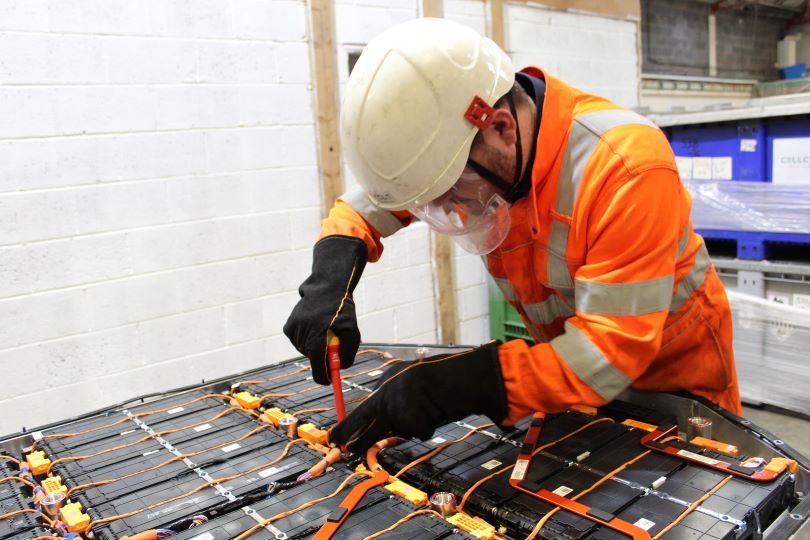Feature
Taking charge: improving safety across the lithium battery supply chain
Scarlett Evans takes a look at the lithium battery supply chain to determine the potential dangers the material poses, as well as the regulations and safeguards that can reduce risks.

Lithium batteries provide a huge amount of energy in a small space. Credit: asharkyu / Shutterstock
Increased demand for clean energy technologies is spiking the production of lithium batteries - used in everything from electric vehicles to laptops. Yet despite the clean energy credentials of these materials, their safe storage and disposal is a point of concern for some companies, evidenced by a factory fire in South Korea this June, killing at least 22 people.
Just how dangerous are lithium-ion batteries?
Fires caused by lithium-ion batteries are by no means common. However, on the rare occasions that something does go wrong, the impacts can be disastrous, with these fires near impossible to extinguish and often releasing a wave of toxic gases into the surroundings.
“When a lithium-ion battery is abused, whether by overcharging or crushing, [it goes] into what's called thermal runaway,” says Paul Christensen, chair of pure and applied electrochemistry at Newcastle University and project lead of the battery safety initiative, SafeBatt.
“[It] gets hotter and hotter while also starting a chemical process that generates huge volumes of gas,
Rates of ‘catastrophic failure’ in lithium-ion batteries are currently only one in 40 million. However, safeguarding against these incidents is of increasing importance.
“What can happen with the larger batteries, for example with electric vehicles, is the battery explodes due to pressure - though this is still extremely rare. Depending on the chemical of the battery, you could get an explosion that creates a fire 10m long or, if the gas gets outside the object and ignites, you can get rocket-like flames at temperatures in excess of 1,000°C.”
The Faraday Institution, an energy storage research consortium, says rates of ‘catastrophic failure’ in lithium-ion batteries are currently only one in 40 million. However, safeguarding against these incidents is of increasing importance as lithium-ion batteries are becoming more prevalent.
There is also a need to establish a sturdy recycling programme for when batteries reach the end of life, as well as to educate workers and consumers alike on the potential dangers they pose.
Battery safety: a matter of education
The main cause of battery explosion, according to Christensen, is human error.
“In my view - and I’ve pinched this quote - lithium-ion batteries don’t commit suicide,” says Christensen. “They’re murdered by people. In other words, it's the human factor because people don't understand them.”
A joint study by battery analytics software provider TWAICE, the Electric Power Research Institute and the Pacific Northwest National Laboratory highlights a lack of workforce training and a lack of interoperability between fire suppression systems as exacerbating battery storage system failures.
To combat the problem, the report recommends better site-specific hazard assessments, better workforce training and better monitoring during all phases of a battery’s life – from design to installation, construction and storage.
“At the moment, there is a real lack of understanding of how these batteries work,” explains Christensen. “If you don’t understand the chemistry, if these lithium batteries are just being used as if they’re a lead acid battery, then you’re basically cruising for a bruising,
A joint study…highlights a lack of workforce training and a lack of interoperability between fire suppression systems as exacerbating battery storage system failures.
“The reason lithium batteries are so brilliant – and I do believe they are brilliant – is that they provide a huge amount of energy in a small space. But this fact also makes them extremely challenging. It’s a double-edged sword. They’re essential to support renewable energies, but you’ve got to know how to use them correctly.” Christensen’s own project, SafeBatt, was established to research the root causes of battery failure, with the team also delivering training to first responders on how to deal with battery explosions.
“Safety considerations have to start right away, back at the design stage and through procurement to assembly, construction and operation,” he adds.
“We’ve also got to be considering the questions of what will happen at the end of a battery’s life, how are you going to deal with them?”
Recycling batteries key for safety and sustainability
Having a robust battery recycling industry is paramount to maintaining not only safety standards but also sustainability and supply chain stability. Recently there has been a new surge in government action to get battery recycling underway.
For one, the EU is introducing a series of regulations to support sustainability and transparency, with the laws set to roll out in stages over the next few years. The most recent law, introduced last June, requires new batteries to contain at least 6% recycled lithium and nickel by 2031.
For now, however, some nations remain behind on industry development. Max Nagle, marketing manager at lithium battery recycling company CellCycle, says the main challenge facing somewhere like the UK is its lack of refining capabilities for lithium batteries.
“We can take the batteries apart, we can shred them, but the material ultimately has to go abroad so it can be refined,” says Nagle. “Developing refining capabilities at home is really the next step because there is going to be a tsunami of batteries reaching the end of life soon, and the bigger the batteries are, the harder they are to deal with. Establishing refineries is really about future-proofing the UK’s supply chain.”

Engineers dismantling a large-scale lithium battery. Credit: Cellcycle
Projects to kickstart the refining process in the UK are already underway, with Nagle saying we could expect to see these becoming “just larger than pilot scale” in the next two to three years.
CellCycle itself has partnered with Coventry University to scale up a bioremediation process for recycling batteries, using bacteria and microbes to sustainably treat lithium batteries, with a research lab set to open at the end of August.
However, there is still some way to go before any of these projects are expected to see significant returns.
“There are quite a few companies working on refining processes in the UK,” Nagle notes. “However, I would say that until the lithium battery feedstock increases in the UK, we will be looking at the late 2020s, closer to 2030s for any of them to be fully operational.”
In addition, regulations around battery storage and recycling need to be updated before wide-scale change can be seen.
Regulatory frameworks for batteries
Potential dangers from lithium batteries are already being reflected in governments’ changing laws to incorporate proper battery management, particularly in the US.
In July, the state of New York updated its fire code to include lithium-ion battery energy storage system safety recommendations, while the state of New Jersey has made it illegal to discard electric vehicle batteries in landfills.
The inclusion of these regulations in national law is an indication that governments are taking the issue seriously, however, legislation is expected to change as the industry becomes more established. As the World Economic Forum (WEF) said: “On the regulatory front, the work has just begun.”
More investment is needed into research on the dangers posed by lithium batteries, and the solutions available to mitigate them.
According to Christensen, more investment is needed into research on the dangers posed by lithium batteries, and the solutions available to mitigate them.
More investment is needed into research on the dangers posed by lithium batteries, and the solutions available to mitigate them.
“The cost of research is huge,” he states. “It's not just the cost of the batteries, it's the disposal costs, the transport costs, etc. It all mounts up and there are very few sites in [the UK] where you can do reasonably large-scale tests, if any.”
With increased private investment, and government focus, the industry has the potential to change, which is necessary to keep incidents down.
“Without a fully funded materials recovery / repurposing / reuse industry, we can never fulfil our decarbonisation targets,” says Christensen. “Ultimately, what will be happening is we'll be dumping lithium batteries, which is a ticking time bomb for the future.”
Speaking to Nagle, he seems optimistic that with the new EU laws, the battery recycling industry is due for improvement, with hopes that nations such as the UK will follow suit.
“The hardest thing to control is people, and there needs to be a real shift in how we look at battery waste,” Nagle says.
“This can only be achieved if we change things right from the start. That’s why the battery regulations from the EU will be very, very integral because they all emphasise producer responsibility, and will put pressure on governments to give funding to the companies that are doing it right or make it easier for upcoming recycling companies to set up.
“I think the industry is on the up. But now is the time to start taking inspiration from other countries.”